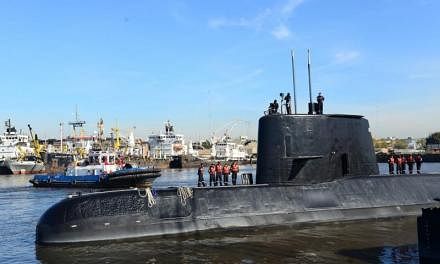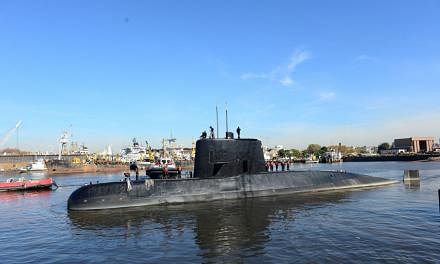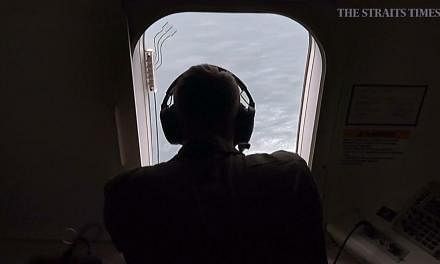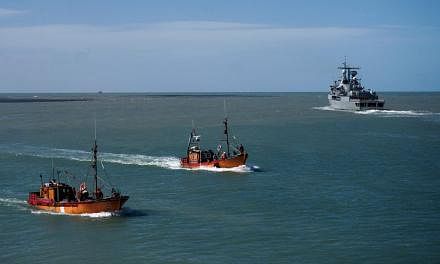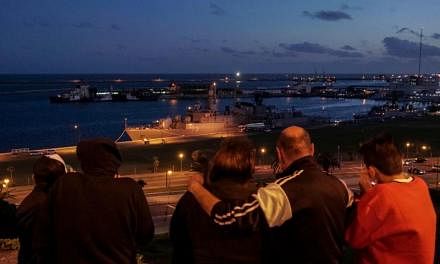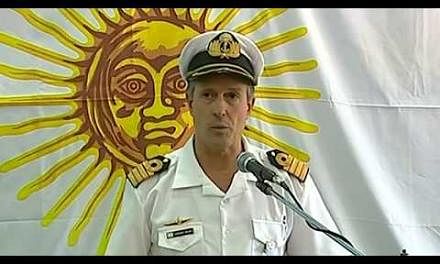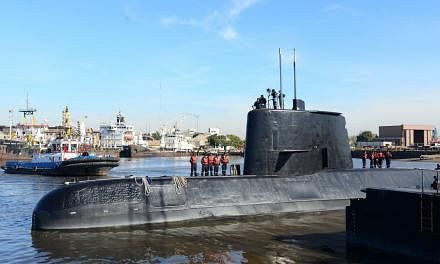MAR DEL PLATA, ARGENTINA (REUTERS, AFP) - A sound detected on Monday (Nov 20) in the South Atlantic, near where an Argentine navy submarine with 44 crew went missing five days ago, is not believed to have come from the ill-fated vessel, a navy spokesman said.
The sound detected by probes initially raised hopes that crew members aboard the ARA San Juan submarine, which disappeared after reporting an electrical malfunction, may have been intentionally making noise to attract rescuers.
But an analysis by Argentine authorities, on the fourth day of a search-and-rescue mission, showed that it was highly unlikely it had come from the German-built submarine, navy spokesman Enrique Balbi told reporters in Buenos Aires.
"It does not correspond to a pattern that would be consistent with bangs against the walls in morse code," Balbi said.
He described whatever had been detected as "a continuous, constant sound".
The disappointment followed another letdown earlier in the day, when the navy said satellite calls detected over the weekend did not in fact come from the vessel.
The vessel reported an electrical problem and was headed back to its base in the port of Mar del Plata when it disappeared on Wednesday, the navy said.
Storms have complicated search efforts as relatives wait anxiously. More than a dozen boats and aircraft from Argentina, the United States, Britain, Chile and Brazil have joined the search effort. The authorities have mainly been scanning the sea from the sky, as storms have made it difficult for boats.

'Breakdown'
Earlier in the day, the navy said the San Juan, a German-built TR-1700class diesel-electric submarine launched in 1983, had reported a mechanical breakdown in its final communication last Wednesday.
The nature of the breakdown was not immediately clear. It was the first time the navy indicated it had been aware of a problem.
"The vessel surfaced and it reported a breakdown. It was therefore asked to change course and go to Mar del Plata," said Gabriel Galeazzi, the head of the naval base in the city, located 400km south of Buenos Aires.
Balbi also told reporters that analysis has shown that seven signals received by naval bases over the weekend were not attempted distress calls from the submarine's satellite phone.
False hope?
Monday's revelations were a blow to relatives of sailors aboard the sub, around 100 of whom are being housed at the Mar del Plata naval base as they await news of the crew.
"They have a lot of hope. The hours go by and the worry rate goes up. The best tranquilliser is accurate information," said Enrique Stein, a member of a psychological support unit set up for the families.
"We don't know anything. We are waiting with a great deal of anxiety," said Andrea Ali, wife of Franco Ali, an electrician aboard the San Juan.
The submarine's fate has gripped the nation, and President Mauricio Macri visited the relatives and prayed with them on Monday.
Macri was briefed on the search during his visit to the base.
On Sunday, a flag was unfurled at the naval base that read: "Be strong Argentina, We trust in God, We wait for you." At the Vatican, Argentine-born Pope Francis said he offered "his fervent prayer" for the safety of the submariners.
Multinational rescue efforts
Search efforts meanwhile have been hampered by inclement weather, including a powerful storm that has whipped up waves reaching seven m in height.
Rescuers are focusing on an ocean patch about 300 km in diameter, radiating from the last point of contact.
US Southern Command has deployed the Poseidon patrol and reconnaissance plane with a crew of 21, as well as a NASA P-3 research aircraft, and other equipment and personnel.
The US Navy has deployed two unmanned underwater vehicles that use a sonar system to create an image of large sections of the sea floor.
Britain's Royal Navy said it had sent the HMS Protector, an Antarctic patrol ship.
The submarine had been returning from a routine mission to Ushuaia, near the southernmost tip of South America, to Mar del Plata.
It is one of three submarines in the Argentine fleet.
Sixty-five meters long and seven meters wide, it was built by Germany's Thyssen Nordseewerke and launched in 1983.
It underwent a refit between 2007 and 2014 to extend its use by about 30 years.

